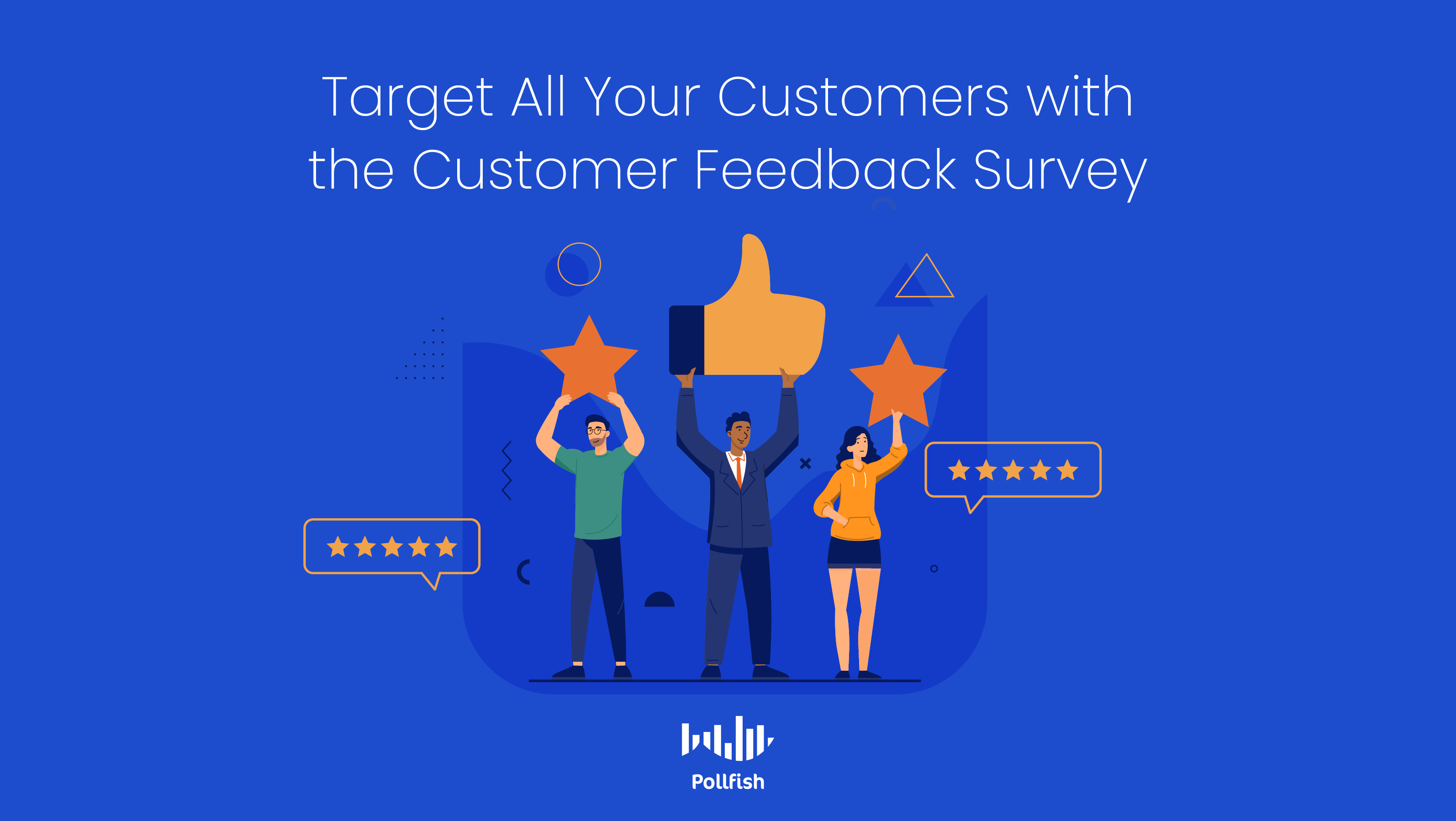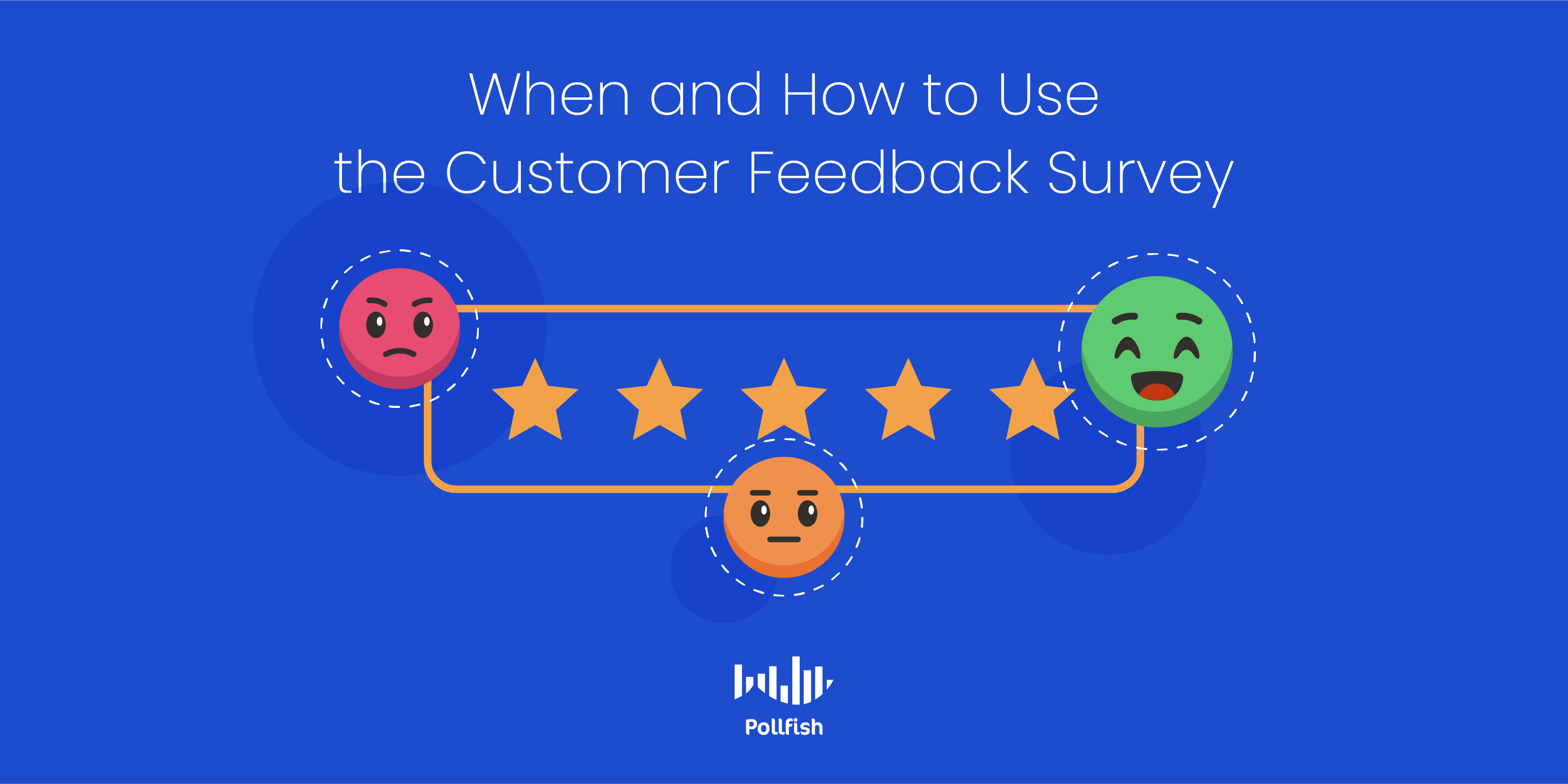Diving Into the Customer Feedback Survey to Target All Your Customers

Using the customer feedback survey is the quickest and most effective way to gain ceaselessly coveted customer feedback. This tool provides access to all the opinions and commentary that members of your target market have.
You can use these surveys to run a survey campaign into virtually any topic that you’d like insights on from your customers themselves. While this kind of Voice of the Customer tool may appear to be too general, it is a necessity for brands — and customers agree.
Filling in surveys may also seem to be a chore, but customers appreciate it when brands take their feedback into consideration, regardless. In fact, 77% of customers view brands more favorably if proactively if they invite and accept customer feedback.
It is evident that businesses must acquire as much customer feedback as possible to inform their actions and improvements.
This article provides an in-depth look into the customer feedback survey, its importance, when and how to use it and more.
Understanding the Customer Feedback Survey
As its name implies, this is a kind of survey for gathering customer feedback, which is an all-encompassing term describing all the information that customers provide about their experience with a business.
In this regard, customer feedback can include commentary and insights into a business’s products, services, and various kinds of experiences, including customers’ overall perceptions during their customer buying journey, known as customer experience (CX).
Through the customer feedback survey, businesses also gain insights into customer behavior and various customer consumer preferences. It can provide quantitative market research through various close-ended questions, including numerical ratings questions, such as the NPS survey (Net Promoter Score).
You can also probe deeply into the minds of your target market sample by forming your customer feedback survey as a means of conducting qualitative market research. You can do this by using advanced skip logic in your questionnaire.
This feature allows you to probe further into customer feedback by routing respondents to specific follow-up questions based on the answers to a previous question. You can also make your customer feedback survey take a qualitative approach by using open-ended questions so that customers can fully explain themselves.
You can gauge your customers on specific experiences and sentiments whenever you need to gather specific feedback, especially the kind that is tied to your various marketing/business campaigns.
The Importance of the Customer Feedback Survey
The importance of the customer feedback survey cannot be overstated. This single vessel of customer feedback provides brands insights into any and every concern their customers have. The key is to use it at appropriate times and to use the proper accompanying online survey platform.
Firstly, this survey provides insights into general customer feedback on a brand, which includes customers’ thoughts, ideas, musings and even insights into their customer buying behavior.
In the age of digital experience and CX in general, it is crucial for businesses to be well-acquainted with their customers’ likes, aversions, needs and more. It is equally important to get their feedback on other matters, as this kind of feedback may point out issues you didn’t know your customers had with your business.
As such, conducting this survey will reveal many issues you didn’t know your brand had, whether it is in the pre-sales stage, the buying stage or the post-sale stage where your customers may return to your brand or switch to a competitor. This kind of feedback allows you to prioritize your efforts on the most pressing matters to your customers.
By understanding your customers’ pet peeves, wants, needs and gathering other feedback, you will, in turn, avoid and lower your customer attrition. Losing customers is never a positive outcome for a business, even less so considering it is 5 times more expensive to acquire new customers than it is to retain existing ones.
The customers that you retain also have a higher probability of buying from your business, as they carry a 60-70% success rate of selling to them. As such, it is critical to avoid customer attrition and maintain a steady flow of existing customers. With the customer feedback survey, you can maintain and increase your customer retention rate, while keeping your customer attrition rate at bay.
Avoiding customer attrition and maintaining customer retention allows you to increase the customer lifetime value (CLV) of your target market. This metric measures the total monetary value a customer has for your business during their relationship with the business.
The longer you retain your customers, the higher their CLV is for your business, representing a constant provider of revenue for your company. As such, the customer feedback survey goes beyond allowing customers to air out their grievances, frustrations and feelings of satisfaction. By supporting customer retention and lowering customer attrition, it helps raise the total value your customers bring to your brand in their lifetime.
However, not all customers provide any feedback. This is problematic, especially when dealing with unsatisfied customers. Only 1 in 26 unhappy customers make their grievances known. Businesses are thus left to fend for themselves when it comes to understanding what makes their customers unhappy, if they can detect this feeling at all among their customers.
The customer feedback survey provides a practical remedy for this, giving businesses an easily accessible tool to extract and gauge customer feedback, whereas, without this tool, most customers would have kept their feedback to themselves.
When and How to Use the Customer Feedback Survey
 You should create and deploy the survey whenever you seek customer feedback. There are specific times during the customer journey that are especially favorable for collecting feedback, as these are the times in which customers still have interactions and intentions fresh on their minds.
You should create and deploy the survey whenever you seek customer feedback. There are specific times during the customer journey that are especially favorable for collecting feedback, as these are the times in which customers still have interactions and intentions fresh on their minds.
Surveying customers at these moments is conducive to their providing feedback that is honest and accurate to their situation and thoughts. The following lists specific times before, during and after the sales cycle in which you should use the customer feedback survey. It also provides examples of the specific kinds of customer feedback surveys to use:
- Top of the funnel interactions and occurrences customers have:
- When customers sign up for a newsletter, first webinar or subscription list.
- When customers visit a company website for the first time without converting.
- When customers enter a store for the first time and leaving an email address
- When customers inquire about a business for the first time.
- Example: Calling a business for the first time to ask if it offers certain products or services.
- Use a brand awareness survey after customers have first encountered an interaction with your company.
- Middle of the funnel interactions and occurrences:
- When customers watch a webinar for the first time after having had previous interactions with a company.
- When customers watch a second, third or further webinar.
- After a potential client or customer inquires about an upcoming event.
- When customers visit a website and bounce or after having made several site visits without purchasing.
- When customers speak with a sales representative early on in the middle of the funnel (especially useful for B2B businesses looking to secure a lead). Use B2B surveys when dealing with partners, vendors and business clients.
- Middle of the Funnel interactions nearing conversions
- After customers chatted with a sales representative via a website chatting system.
- After customers exchanged emails with a company (especially in B2B settings).
- After thoroughly discussing an integration, plan of action, offerings at length and contracts with an MQL (especially in B2B settings).
- After site visitors browse a website and call/chat about specific products, services and promotions.
- End of the Funnel: Beginning of Purchases
- When customers abandon their shopping carts.
- Use a consumer survey to ask why they abandoned their shopping cart, if they intend to return and what would make them purchase.
- Use the CES (Customer Effort Score) survey to quiz the difficulty customers had with the checkout process or any other part of their CX.
- When customers call in or chat before making their purchase.
- Use the customer experience survey to ask whether your staff answers all of the customers’ questions, if they were helpful and if they pushed them to finally purchase.
- When customers pay for a paid service such as a subscription.
- When customers abandon their shopping carts.
- Post-Sales
- After customers check out their purchase.
- After customers canceled their orders.
- After a certain period of time passes post-purchase as a means of checking up on the customers.
- Use a CSAT (Customer Satisfaction Score) survey to determine the levels of satisfaction customers have with your business throughout their CX and especially with the product.
- Use the product satisfaction survey to gauge how well your product is received and whether customers encounter any glitches/bugs.
- Use an NPS survey to determine how likely customers are to recommend your business to others.
How to Apply the Customer Feedback Survey
You should target specific customers based on their interactions with your business by emailing them your surveys. This can also be done via the following ways:
- Asking customers to take your survey at different social media channels
- Routing them to a customer satisfaction survey in-person (by soliciting their email in-store or at a place of sales.
- Emailing customers your survey based on those in a CRM system or subscription list.

- Deploying surveys to a vast publishing network during, before and after various campaigns, such as advertising, PR, branding and various marketing campaigns.
- Targeting specific customers by emailing them a customer feedback survey.
- These can also be those who don’t know about your business but are part of your target market.
Gaining All the Customer Insights You Need
You should always aim to get as much customer feedback as possible, as it can be applied to numerous campaigns, as well as to simply get a better understanding of the state of your niche, customers and cultural trends.
To extract and elicit feedback from customers, you’ll need to use the customer feedback survey. In order to form and deploy such a survey, you’ll need to use an apt online survey platform, ideally, one that is easy to use, allowing you to make a survey in just three easy steps.
Additionally, a strong online survey platform operates via random device engagement (RDE) sampling, enabling you to reach respondents in their natural digital habitats, as opposed to pre-recruiting them.
You should also use a mobile-first platform, as mobile dominates the digital space, so you would need a survey tool built with the best mobile experience.
The platform you use should also offer artificial intelligence and machine learning to remove low-quality data, offer a broad range of survey question types and disqualify dodgy respondents.
Most importantly, it should allow you to survey anyone. As such, you’ll need a platform with a reach to millions of consumers, along with one that offers the Distribution Link feature.
This feature will allow you to send your survey to specific customers, alongside deploying them across a network.
When you use an online survey tool with all of these capabilities, you’ll be making the most out of your customer feedback survey.
Do you want to distribute your survey? Pollfish offers you access to millions of targeted consumers to get survey responses from $0.95 per complete. Launch your survey today.

